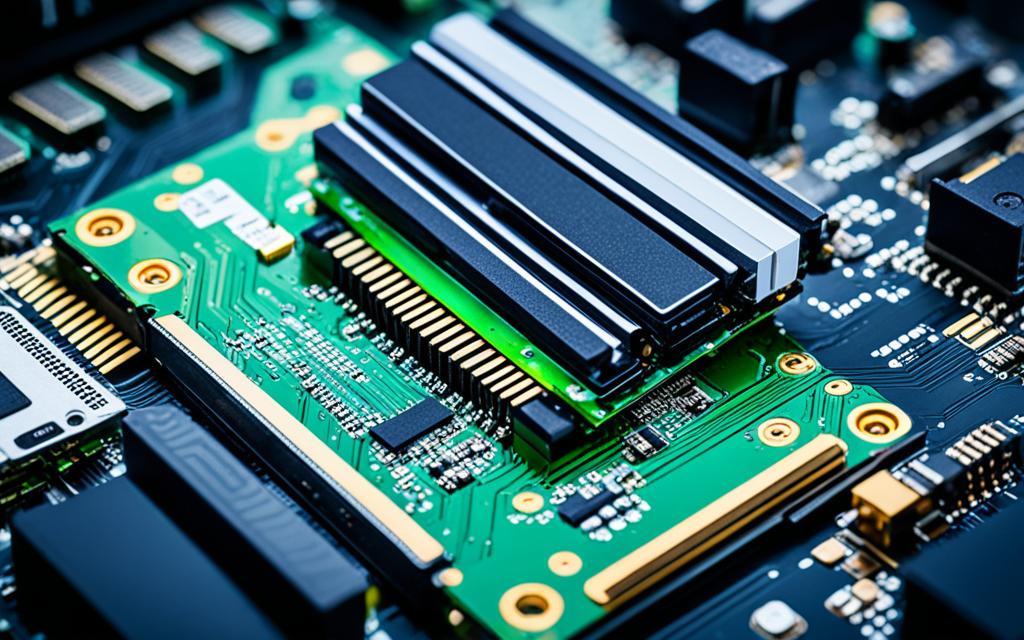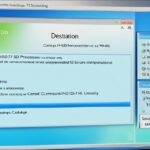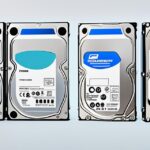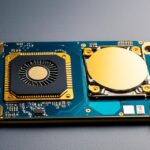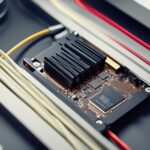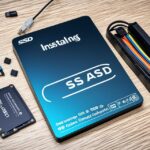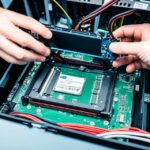Table of Contents
Transferring data between M.2 SSDs can boost your system’s startup and improve how fast applications and games load. M.2 SSDs are now the go-to choice for upgrades, offering a straightforward way to move data. Yet, many find the cloning process tricky, leading to mistakes and confusion1. It’s essential to grasp the tech behind M.2 SSDs and the available data migration techniques for a smooth changeover. This guide will explore how to clone your old SSD successfully, ensuring your data stays safe and your system’s performance gets better.
Key Takeaways
- M.2 SSDs are chosen for their top speed and efficiency compared to HDDs.
- Backing up vital files before cloning is wise to prevent losing any data1.
- Use tools like MiniTool ShadowMaker or MiniTool Partition Wizard for an easy data move2.
- Convert the old SSD from MBR to GPT for a seamless change, especially for UEFI mode1.
- Make sure the M.2 SSD fits with your motherboard to install it successfully.
Understanding M.2 SSDs
M.2 SSDs are a major leap forward in storage solutions, crafted for the needs of today’s computers. They’re slim and can plug right into the motherboard. This makes them a top pick for users wanting to boost their computer’s speed.
What is an M.2 SSD?
An M.2 SSD is a compact, slim solid-state drive. It came around in 2012 to take over from the old mSATA.These drives range in width from 12mm to 30mm and lengths from 16mm to 110mm3. You can get M.2 SSDs with either SATA or NVMe interfaces. SATA versions can transfer data at 6Gbps max. But NVMe models can go as fast as 20Gbps, far outshining SATA ones4.
Benefits of Upgrading to M.2 SSDs
Switching to M.2 SSDs has many upsides, especially in speed. M.2 NVMe drives often exceed 5000 MB/s in read and write speeds. That’s much quicker than the 550-600 MB/s of SATA SSDs3. The PCIe interfaces of M.2 SSDs use up to four lanes. This makes them four times as fast as SATA connections. This boost in speed improves how responsive your system is3.
These SSDs can hold up to 2TB. That’s perfect for small and portable computers like laptops and ultrabooks. Their flexibility is another plus4.
Upgrading boosts how quick games load and how fast your system starts. It also betters performance with lots of data. Plus, these drives are more reliable and last longer than hard drives. They’re great for anyone wanting better storage options.
Preparing for Data Transfer
Before you start transferring data between M.2 SSDs, it’s important to prepare well. This makes sure the process runs smoothly and efficiently. You’ll need to check if your system is compatible, pick the right M.2 SSD, and get the tools and software you need.
Checking Your System’s Compatibility
The first thing to do is check if your system will work with the new M.2 SSD. Look at your motherboard to see how many M.2 slots it has and if it supports SATA or NVMe M.2 SSDs. It’s important to get this right to avoid any problems. The size of the M.2 SSD should also fit your motherboard’s specs in terms of length and thickness.
Choosing the Right M.2 SSD for Your Needs
Choosing the correct M.2 SSD is key when upgrading your storage. Companies like Kingston® provide options from 512GB to 4096GB. They offer fast speeds up to 7,000MB/s with PCIe 4.0 NVMe technology5. Knowing this helps you pick an SSD that matches what you need in terms of performance. Think about how much storage you need for your data, as M.2 SSDs can go up to 8TB6.
Gathering Required Tools and Software
Having the right tools makes moving your data easier. AOMEI Backupper Professional is recommended for its useful features. It offers smart cloning options and supports resizing partitions. It’s also good for cloning M.2 SSDs of various sizes, up to 4TB76. Make sure you’ve also set up a reliable backup before you start transferring data.
| Software | Key Features |
|---|---|
| AOMEI Backupper Professional | 30-day free trial, intelligent sector mode, sector-by-sector clone, SSD alignment |
| AOMEI Backupper Standard | Free edition, basic cloning features, user-friendly interface |
| Acronis Cloning Software | Facilitates SSD installations, easy to use, instructional videos available |
How to Transfer Data from One M.2 SSD to Another
Transferring data between M.2 SSDs can boost your system’s speed. You can clone data or transfer it manually. Knowing how to do this makes migration a breeze. Let’s look at the cloning method first, as it’s quite popular.
Cloning the SSD
Cloning makes an exact copy of your SSD onto a new one. It’s fast and doesn’t need many settings to be changed. First, plug in the new SSD via a USB adapter. Then, use trusted cloning software. EaseUS Disk Copy is a good choice for this. When you’re done, swap the old SSD with the clone. This makes sure your system starts right up from the new SSD.
Using Image Backup and Restore
Another way to move data is using backup and restore. This keeps your data extra safe. Start by making a full image of your SSD. This image is like a data snapshot. Next, restore this image to your new SSD. All your files and settings will move over too. This method is slower than cloning but it’s very secure.
Steps for Manual Transfer
If you prefer doing things yourself, try manual transfer. Get your new SSD ready and make sure it’s formatted. Then, connect both SSDs to your computer.
Use tools to move files from the old SSD to the new one. This way, you choose exactly what gets transferred. It might take more time and effort, though.
| Transfer Method | Advantages | Considerations |
|---|---|---|
| Data Cloning | Quick and straightforward process | Requires cloning software |
| Image Backup and Restore | Safeguards data with a complete image | Takes longer than cloning |
| Manual Transfer | Greater control over transferred data | More time-consuming |
Your needs decide which method suits you best. Think about ease, security, and time. Whichever transfer methods you pick, follow the steps for successful data transfer.
For detailed info on cloning and tools, see this resource8.
In today’s fast-changing tech world, knowing these methods is powerful. Embrace these changes. Improve your storage solutions with easy data transfers.
Post-Transfer Steps
Once the data transfer is finished, we must focus on what comes next. Making sure the data has been properly transferred is key. This includes checking that all files and applications work just as expected.
Look over system settings and ensure all applications run well on the new SSD. It’s good to have troubleshooting guides ready. They are useful, especially if you encounter any problems starting your computer.
Verifying Successful Data Transfer
Data verification is all about making sure everything moved over is both complete and works. You can use special software to compare data, making sure nothing is missing or damaged. Doing checks like these regularly keeps your data safe and prevents loss.
Managing Your Old M.2 SSD
After you’ve made sure your data transfer went well, think about what to do with your old M.2 SSD. You might use it for extra storage, wipe it clean, or recycle it. Taking good care of the SSD is important, especially if you keep using it.
Update its software and check its health to keep it running smoothly. Following the best data management tips also helps it last longer.
Conclusion
Transferring data to an M.2 SSD can seriously boost your system. With the correct setup, this process can be highly effective. Cloning data is a popular method because it’s efficient and ensures a smooth changeover. This means moving from your old SSD to a new one is easier than ever9. Plus, M.2 SSDs can work at amazing speeds up to 3500 MB/s. They not only make your computer faster but also more responsive1011.
Using software like AOMEI Partition Assistant Professional and EaseUS Todo PCTrans makes everything simpler. These tools help meet different needs and tastes910. Solving issues around compatibility and keeping your data safe can make you feel more confident. Thus, you’ll likely be happier with your new M.2 SSD.
For those keen on improving their systems, M.2 SSDs are a game-changer. They’re not just about faster speed but also about making storage more reliable. In our fast-paced tech world, selecting M.2 SSDs can be a big boost to both your system’s performance and its lifespan9.
FAQ
What is the difference between SATA and NVMe M.2 SSDs?
SATA M.2 SSDs are based on the older SATA interface, leading to slower data transfer speeds. On the other hand, NVMe M.2 SSDs use the PCIe interface. This makes them much quicker, which is great for tasks that need lots of data.
How can I check if my motherboard supports M.2 SSDs?
To find out if your motherboard can handle M.2 SSDs, take a look at the user manual. You can also visit the manufacturer’s website. There, search for M.2 slot specifics and what interfaces are supported.
What is the cloning process for transferring data between M.2 SSDs?
Cloning means making an exact copy of your old M.2 SSD on the new one. This is done with special cloning software. First, you connect the new SSD using a USB adapter.
After cloning, you place the new SSD where the old one was. This way, your system will start from the new SSD.
What tools do I need for data migration from M.2 SSDs?
You will need a few things for data migration. A USB to M.2 adapter and cloning software are must-haves. Names to look for include Macrium Reflect or Acronis True Image. A screwdriver might also be needed to install the new SSD properly.
How can I ensure the data transfer was successful?
After the data transfer, make sure all your files are on the new SSD. Everything should work just like before. If something’s wrong, especially with starting the system, run some checks to find and fix the issue.
Can I use my old M.2 SSD after upgrading?
Certainly, your old M.2 SSD can be used again. It can serve as extra storage. Or, you might want to keep it as a backup. That’s if it’s still working well, of course.
Source Links
- https://www.easeus.com/backup-utility/migrate-os-to-m.2-ssd-with-m.2-ssd-clone-software.html – [Beginner’s Guide] Migrate OS from SSD to M.2 SSD with M.2 SSD Clone Software
- https://www.minitool.com/backup-tips/transfer-data-from-one-ssd-to-another.html – How to Transfer Data from One SSD to Another? Try 2 Ways!
- https://www.crucial.com/articles/about-ssd/m2-with-pcie-or-sata – NVMe vs M.2 vs SATA vs PCIe: What are these SSDs?
- https://www.kingston.com/en/blog/pc-performance/two-types-m2-vs-ssd – 2 Types of M.2 SSDs: SATA and NVMe- Kingston Technology
- https://www.kingston.com/en/blog/personal-storage/install-m2-ssd – How to Install an M.2 SSD- Kingston Technology
- https://www.ubackup.com/clone/clone-m2-ssd-to-m2-ssd-5740i.html – How to Clone M.2 SSD to Larger M.2 SSD (Secure Boot)
- https://www.ubackup.com/clone/how-to-move-files-from-one-ssd-to-another-6688.html – How to Transfer Data/Files from One SSD to Another [2 Ways]
- https://www.playstation.com/en-au/support/hardware/ps5-install-m2-ssd/ – How to add an M.2 SSD to a PS5 console (Australia)
- https://www.diskpart.com/articles/transfer-ssd-to-new-ssd-7201.html – How to Transfer SSD to New SSD Without Losing Data
- https://www.easeus.com/pc-transfer/transfer-data-from-hdd-to-m2-ssd.html – How to Transfer Data From HDD to M.2 SSD [2 Helpful Methods]
- https://recoverit.wondershare.com/data-backup/clone-hdd-to-m2-ssd.html – 3 Efficient Methods to Clone HDD to M.2 SSD [2024]

